July 16, 1907 – January 20, 1990
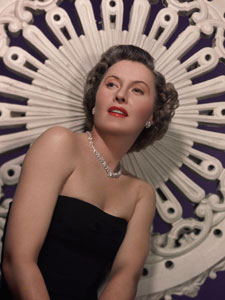
By Gary Sweeney:
Ruby Catherine Stevens was born on July 16, 1907 in Brooklyn, New York to Byron and Catherine McGee Stevens. The youngest of five children, Ruby learned early on about hardship. The family was on the lower end of the financial scale and the circumstances that arose from that poverty instilled toughness in Ruby that lasted throughout her life. At the age of four, Ruby’s mother Catherine was pushed from a streetcar by a drunken passenger, which killed her almost immediately and left the Stevens children with a single parent. Byron Stevens, however, took work a few weeks after his wife’s funeral digging the Panama Canal and never reappeared in his family’s life. An older sister, Mildred, essentially began raising young Ruby and their brother Byron, until Mildred took a job as a showgirl for John Cort. Cort was a highly influential showman whose theater circuit was born from his success during the Klondike Gold Rush in the late 19th century. Mildred Stevens jumped at the chance to work for him. Unfortunately for Ruby and Byron, this meant being placed in a foster home – the first of many.
Ruby seemed to dislike rules from the beginning, at least where school was concerned. She never really accepted the foster home lifestyle and regularly escaped. By the age of ten, she was watching her older sister Mildred perform in various routines; and combined with an adoration for Pearl White (a respected silent film actress known for her stunts), Ruby set her sights on making something of herself. The next few years were filled with menial jobs, but they gave her a sense of independence and she dropped out of school to work full time at the age of 14. This would have been about 1921 and I don’t believe child labor laws had really been established. In fact, if I remember correctly, restrictions on child labor did not really come into play until the Great Depression. Prior to that, children worked in really hazardous situations with no laws to protect them. Without going too far into that (because it’s not really relevant to the story), Ruby’s jobs were usually in stores and shops – nothing really dangerous, but she didn’t like them. Her mind and heart was elsewhere, namely, in show business.
By the early 1920s, Ruby was auditioning for her own gigs. After one such audition on the roof of the Strand Theatre in NYC’s Times Square, she became a chorus girl in the 1922 and 1923 Ziegfeld Follies; and although I hate to think she would have anything to do with Florenz Ziegfeld Jr. outside of work, slots in his productions were highly sought after by many women. This gave him a certain “advantage”. You can fill in the blanks here. Ziegfeld was pretty notorious, at least from what I’ve heard, for his “audition process”. That is not to say that Ruby could not have gotten the job on her talent alone, but we’ll never know the answer one way or the other.
Just after the mid-portion of the 20s, Ruby got what could be considered her first big break. She landed the part of a chorus girl (since she was a real-life chorus girl) in a play called The Noose (written by Willard Mack, later made into a 1928 film starring Richard Barthelmess and Thelma Todd). During its initial run, the play was a bomb and closed soon thereafter. However, it re-opened on Broadway on October 20, 1926 at the Hudson Theatre and was wildly successful, coming in at just under 200 performances. I’m guessing some changes were made to the scenes or to the characters. Whatever happened – it worked, and it was during this time that Ruby Stevens would become someone else – another person who would eventually be lauded as one of the best actresses of her generation. The best source of information that I have is from Barbara herself and tells the story like this:
“We were in Belasco’s office over the Belasco Theater . . . The two men were talking about my name, I heard Belasco say, ‘She can’t go on as Ruby Stevens, sounds like a burlesque queen’s name.’ As he talked he was leafing over some old theater programs. One of them, it was thirty years old, was the program of Jane Stanwyck in Barbara Frietchie . . . They both looked at the program again and as one man, said ‘Barbara Stanwyck!’ And it was done.”
The “Belasco” she is referring to is David Belasco, a playwright and theater impresario. I should mention something here: many Stanwyck enthusiasts, in trying to corroborate the story of her stage name, have searched not only for the aforementioned theater program, but for information on the actress Jane Stanwyck, and have really come up with nothing. Again, we’ll never know for sure if this was a story invented for PR purposes or if it actually happened. Hollywood is known for inventing back stories. If you remember my interview with Lana Turner‘s daughter Cheryl Crane, she told me that the name “Lana” just popped in her mother’s head and that she was not discovered in Schwab’s Drug Store. But it sounded good enough for Hollywood to sell. However, “Barbara Fritchie” was indeed a real person – so who knows? It could be true.
Anyhow, back to Barbara. During the run of The Noose, Barbara became romantically involved with one of her co-stars, Rex Cherryman. Her performance in the play had earned her some well-deserved acclaim, and she was invited to audition for a role in a major motion picture called Broadway Nights. She won the part of a fan dancer; it was her first official big screen appearance (it was also the first big screen appearance of classic actress Ann Sothern, who played a fan dancer as well). Continuing to act on stage, Barbara met a man named Frank Fay. They were introduced to each other by Oscar Levant (if you ever have the interest and time to read Harpo Marx’s autobiography, Harpo Speaks, there are some hilarious stories in there about Levant). Her love interest Rex Cherryman died unexpectedly of septic poisoning in Le Havre, France in August 1928. He was 31 years old. His body was returned to Hollywood and his cremated remains are at Forest Lawn Glendale. Cherryman is buried with his wife Esther, which means that his involvement with Barbara was an extramarital affair. After Cherryman’s death, Barbara and Frank Fay became close, though all accounts suggest they didn’t really like each other at first. They were soon married and moved to Hollywood shortly thereafter. It was the first marriage for both of them.
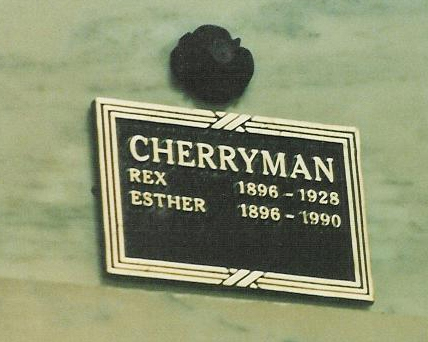
In 1929, Barbara made her first “talkie” called The Locked Door and quickly followed it with Mexicali Rose. Neither film was very successful and threatened to end her film career before it ever really got off the ground. During an audition with legendary director Frank Capra, Barbara became extremely upset and stormed out the room crying hysterically. Apparently Capra had talked to her a bit condescendingly, criticizing her as an actress and making her think less of herself. Frank Fay, after seeing his wife rattled to such a degree, marched into Capra’s office and demanded he give her a screen test. Three cheers for Frank Fay, because Capra did give her a screen test and subsequently cast her in his 1930 film Ladies of Leisure. Despite the initial rockiness of their relationship, Capra and Stanwyck went on to form a strong professional bond in the film industry.
Barbara and Frank Fay adopted a son in December 1932 and named him Dion Anthony Fay. Of the adoption, Barbara told an interviewer: “He’s the best Christmas present anyone ever had. I never thought I’d be one of those hysterical mothers–but when he crooks just one tiny baby finger, I come crawling on my hands and knees. And I love it!” Barbara loved being Dion’s mother but eventually began to hate being Frank Fay’s wife. Initially, reports of marital unrest were denied by Barbara herself. I specifically remember one of her quotes to a popular Hollywood magazine at the time: “I’ll never divorce Frank Fay and Hollywood can’t make me!” I believe she was in some sort of denial, because she did divorce Fay in 1935 and then began a pretty rigorous custody battle for Dion. Fay wanted visitation rights but Barbara lobbied against that, telling the courts “He drinks to excess and once, drunk, threw my son into the swimming pool.” In the end, Fay was granted visitation twice a week. Believing Fay would be a terrible influence on Dion, Barbara continued to fight the visitation decision until Fay gave up and disappeared. One can assume that this did something to Dion; he would eventually become estranged from his mother.
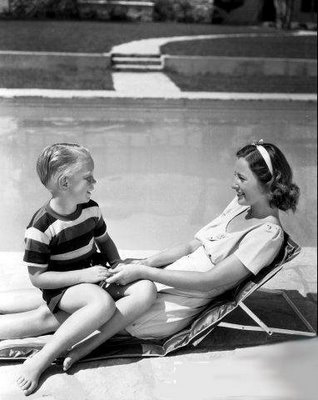
An article in the November 1967 issue of Movie Mirror sums everything up:
In 1947, she sent him to one of the military schools on the West Coast. But he was forever getting into trouble and running away from school. The next thing anyone heard from him was in 1952 when he enlisted in the Army, apparently against Barbara’s wishes. Nobody knows what happened after that–maybe Barbara was too over-protective, maybe she couldn’t stand his going out on his own or maybe the custody fight left too much bitterness for them to overcome. In any case, mother and son never saw or spoke to each other again after that day. It is known that he has since married and had a child, but Barbara is completely lost to him and has never seen her grandchild.
The year following her divorce from Fay, Barbara met fellow actor Robert Taylor during the filming of His Brother’s Wife. The two were instantly inseparable, in love, and eventually married in 1939. Taylor was reportedly unfaithful to Barbara during their union, carrying on affairs with stars like Ava Gardner and Lana Turner, all the way down to up-and-coming- starlets. After a tryst with one of these starlets became public in 1950, Barbara filed for divorce from Taylor; the divorce was granted on February 21, 1951. The ex-couple did appear together in 1964’s The Night Walker. Taylor’s widow’s peak working overtime and Barbara letting out many gut-wrenching screams (those who’ve seen the film will know what I’m talking about).
Aside from her film work, Barbara enjoyed a successful television career in series like The Big Valley and The Thorn Birds. She also appeared in a few episodes of Dynasty,and her role in the show spawned a doomed spin-off called The Colbys. Personally I always enjoyed some of her “so-bad-they’re-good” television movies like The House that Would Not Die and A Taste of Evil.
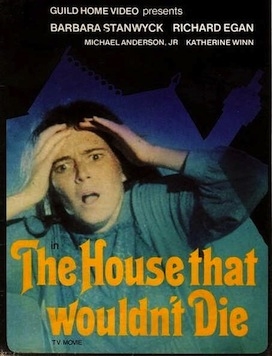
Stanwyck lived in the Trousdale Estates section of Beverly Hills. In 1981 she was the victim of a home invasion. The intruder hit her on the head with a flashlight and forced her into a closet. He made off with $40,000.00 in jewelry. During the ordeal, she was beaten pretty badly and it prompted her to withdraw from the majority of public events. In June of 1985 her house was badly damaged in a fire.
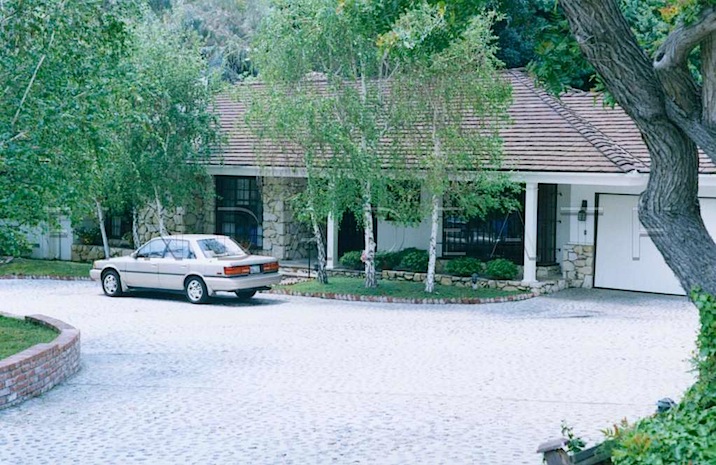
She was described by colleagues as “no nonsense” and “an uncompromising professional.” See you next Tuesday. Apparently she and Charlton Heston clashed often on the set of The Colbys, Heston stated, “On the set she isn’t Little Mary Sunshine. All of us take 50 minutes for lunch, 10 for makeup and we’re back on time. The reason is simple, We know that Barbara will be waiting if we’re not.” She always affectionately referred to him as “Moses.” Findadeath friend Mark Langlois also clarified the fact that Stanwyck had no time for unprofessional people. Co-star Tracey Scoggins suffered the brunt of that when she arrived late from makeup one day. Tracey once stated, “She’s rough on the younger players who don’t have discipline.”
Her signature role was that of the femme fatale Phyllis Dietrichson in Double Indemnity. Couldn’t they come up with a more menacing name than Phyllis? Fred MacMurray plays the private dick, Walter Neff. The house from the film still stands in the Hollywood Hills. The film itself is still amazing.
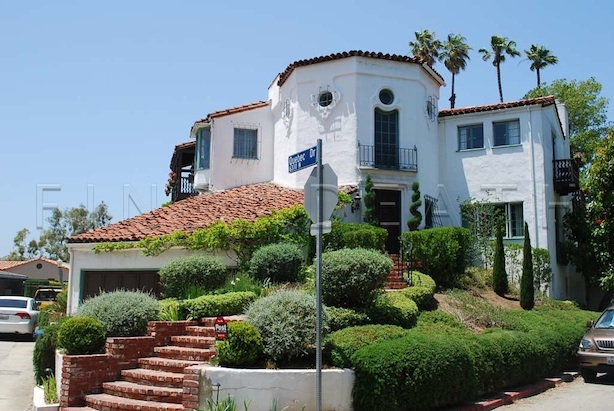
Though she was known throughout her career as “the best actress who never won an Oscar”, Barbara Stanwyck was indeed presented with an honorary Academy Award in 1982 “for superlative creativity and unique contributions to the art of screen acting.” After the ceremony, a reporter asked if she was satisfied with what she had accomplished: “It’s not … satisfaction exactly,” she answered. “Let’s say I did what I was supposed to do. I did my work.” Exhausting.
Barbara’s health had failed dramatically during the last 5 years of her life. She was admitted to St. John’s Hospital in Santa Monica around the 13th of January 1990 – with pneumonia.

She also had lung disease and Emphysema. Her heart stopped beating on Saturday the 20th, just before 5 in the afternoon. Done and dusted, she was 82 years old.
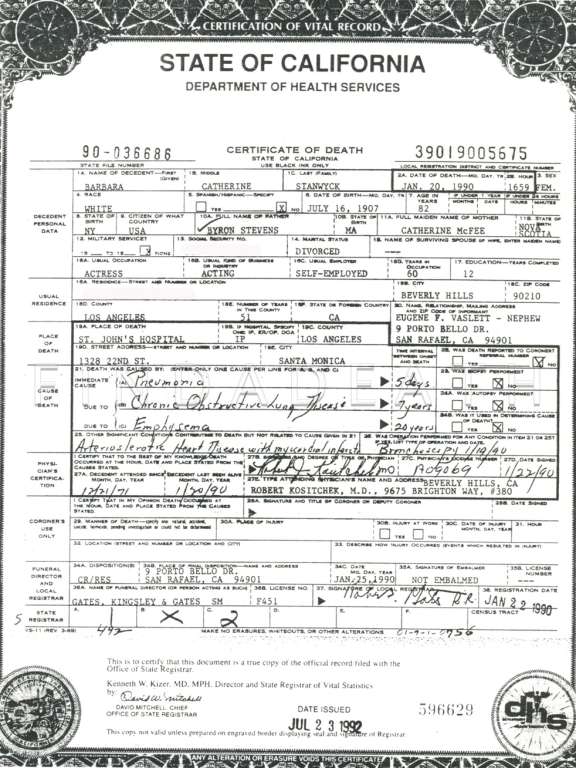
Upon hearing the news of her death, Charlton Heston issued a statement to the press: “I realize it’s no longer a fashionable phrase, but she was a great broad, in all the meaning of the word, and she would be comfortable with that phrase.”
At Barbara’s request, no funeral was planned. She was cremated five days later, and her ashes were scattered over Lone Pine California, near Sequoia and Kings Canyon National Parks.
In Stanwyck’s will, she specifically stated “I have intentionally and with full knowledge omitted to provide for my heirs…” Interesting stuff, available here.
There has never been a so-called “definitive” biography written on Barbara Stanwyck. Two authors, Axel Madsen and Jane Ellen Wayne, who I prefer not to read based on their history of trashing people posthumously for money, have released books on her. However, there are three very good books on Barbara that I would like to recommend:
Barbara Stanwyck: A Biography by Al Diorio (1984), Starring Miss Barbara Stanwyck by Ella Smith (1988)
The Films of Barbara Stanwyck by Homer Dickens with an introduction by Frank Capra (1987)
One final note: A couple years ago, I was in contact with someone who knew Barbara Stanwyck’s former press agent, Larry Kleno. Being a Stanwyck fan, I asked about the possibility of interviewing Larry. He politely declined, simply because he said that he was giving all of his information on Barbara to a biographer who had been working for some time on a comprehensive, thoroughly-researched Stanwyck book. That being the reason, I wasn’t the least bit upset. I just hope the book sees the light of day.
Trivia: In the 40s, she was traveling with her maid – who happened to be black. One of the hotels they booked in to, had a “no blacks” policy. Barbara could stay, but the maid couldn’t. Barbara up and left, and both she and her maid stayed in a “blacks only hotel.” Barbara did all that, just to stay with her servant.
More: There is a quirky little hotel in Flagstaff, Arizona called the Monte Vista. Love. I stayed in the glamorous Barbara Stanwyck suite.
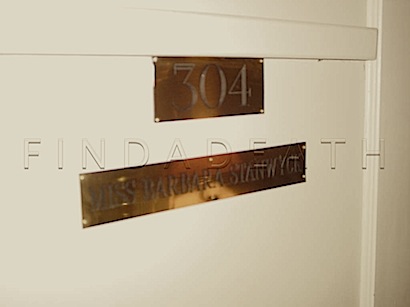
More: Stanwyck is Tori Spelling’s godmother, and her godfather is Dean Martin. Donna Lethal unearthed the factoid that it was Barbara that got the Spellings to stop calling her Vicky, and to call her Tori.
March, 2003: Stanwyck is back
When I returned to Los Angeles in 2002, there was a square missing from the forecourt of Grauman’s Chinese Theater. I had no idea whose it was, but this week, the square was replaced. It turns out that Barbara Stanwyck and Robert Taylor’s footprints were repaired. It was in such poor shape, they took it out in loads of tiny pieces. It took a few months, but they lovingly restored them, and Missy’s slab was returned. I spoke to the girls that were putting them back in place. Allison and Suzanne. Thank you. Your work is definitely appreciated.
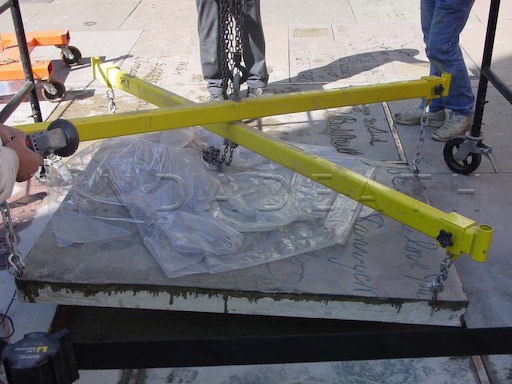
Salacious rumor: Was she a lezzer? This is a quote from one of the greatest dishy books ever printed, “Hollywood Lesbians,” by Boze Hadleigh.
Q: Do you think bisexuality was very widespread among female stars during Hollywood’s heyday?
A: … I heard that Dietrich, Garbo, most of the girls from Europe, swing either way. Then I found out it’s true.
Q: You found out…?
A: Next!
The interview concludes with, “Just please, GET OUT!”
There was something about Stanwyck that has bothered me for years. Just couldn’t quite put my finger on, regarding Barbara. This picture of Ed Wood as Glenda comes close. Just sayin.
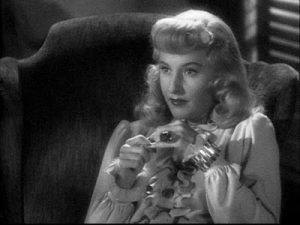
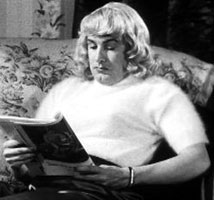
Thank you, Gary. Visit Gary’s website – a treasure trove.


She was very good friend of Lee Major’s, who she mentored when he first started out. And they remained friends until she died.
Edith Head was Barbara Stanwyck’s favorite designer. One day, about 1941, Edith was work with Barbara. Barbara asked her why she never smiled? Edith said, I lost my side teeth due to an infection and I feel shy smiling. Right then, Barbara threw her dress on, grabbed Edith by the hand and said, come with me. Barbara took Edith to the most expensive dentist in Beverly Hills and picked up the check. That was the kind of woman she was.
Alltime favorite Stanwyck photo:
https://encrypted-tbn0.gstatic.com/images?q=tbn%3AANd9GcQuCJ1UpaRB3nPc-_meV4ZGKrN9DUwKp9NRQw&usqp=CAU
Doesn’t she look extremely fit & happy? Believe taken at her Northridge ranch from 1937-40, between the times she built & sold it. Cool house & so unlike a movie star of the era, no phone!:
Sites to house, which is now a public park! Can’t believe it hasn’t been turned into condos or a strip mall in this day and age!
https://uc.ink/trD5W?pub=link [Stanwyck Residence – Northridge – Paul Revere Williams]
https://uc.ink/trIYi?pub=link [A Visit to Marwyck Ranch, Barbara Stanwcyk’s Paradise in the Valley]
Hated how “blurry” my favorite Stanwyck photo posted. Hopefully this one will be better:
http://ic.pics.livejournal.com/vp19/11600353/3519096/3519096_original.jpg
Much better. “Click” on it, it “blows-up” much larger.
Must commend author Michales – insightful, compassionate study. My two cents: Given her hard-scrabble birth, guessing Barbara (at least early on) traded physical favors for job advancements. Would be surprised if she hadn’t.
Also assume a percentage of those encounters were physically brutal or emotionally “transactional”. Given those realities who could blame Stanwyck if her affection parameters were codified with women? As you referenced, think (paraphrasing) Dietrich said it best: “Europeans have sex with people they find attractive.” Notice the gender neutrality?
Like James Dean decades later, Robert Taylor was reputed to have “walked the streets” as a youth. Really believe his marrage to Barbara was studio arranged initally, although they really did seem to care for and about each other. One story read was about comming home from an anniversary dinner out and one of them (stories vary as to which one) went to get more comfortable & emerged from the bedroom naked with the phrase “Come and get it”. Only to discover the living room full of party guests to witness “their love”. Stories like that make me think they really were trying too hard to convince everyone –
As you reported, Taylor was reputedly notoriously unfaithful and read Barbara issued the divorce threat to shock him into reality. Apparently she was shocked that he signed the divorce papers. Got the impression he really was the love of her life, perhaps hindsite gave her that view. Having been married to the grotesque Frank Fay can anyone blame her?
Love her reputed quote while starring on “The Colby’s” tv soap. Apparently after a string of European guest stars of the ilk of Gina Lollobrigida she stated “No more European tarts!” Remember only one eposide scene where one of her family members shoplifted something in a jewelery store. The owner refused to drop the charges no matter what was offered in payment. Barbara’s character’s response? She bought the mortgage on the store and/or business and gave the snotty owner his choice. Drop the charges or immediately pay the mortgage!
The Midnight Palace website doesn’t seem to exist anymore, sadly.